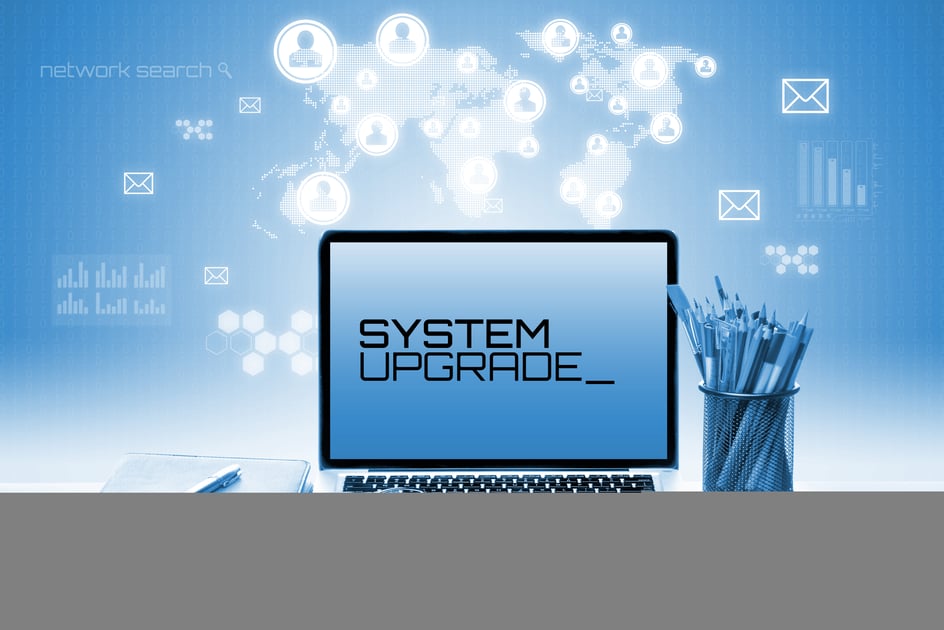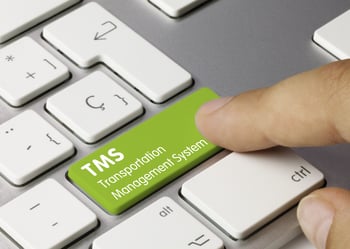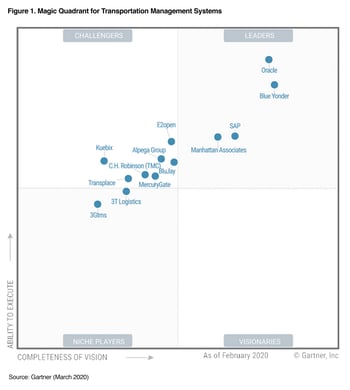
 It can be argued the transportation management software (TMS) system is the most important IT software platform companies need to drive a competitive advantage in their industry. The reason for this thought is supply chain management has increasingly become far more complex and customers are demanding more.
It can be argued the transportation management software (TMS) system is the most important IT software platform companies need to drive a competitive advantage in their industry. The reason for this thought is supply chain management has increasingly become far more complex and customers are demanding more.
Why it took so long for supply chain management to be the number one topic in boardrooms is a bit puzzling, but this trend is here to stay. Just look at the results of the companies that figured it out early. Companies like Amazon, Apple, P&G, McDonald’s and Unilever have seen tremendous market share growth and financial gains through their incredible supply chains . The global COVID-19 pandemic further magnified their success.
The key component of a world class logistics and supply chain strategy and execution starts and ends with a transportation management software (TMS) system and the great news is the software-as-a-service (SaaS) cloud TMS systems have given all shippers, no matter their size, access to a top tier TMS for their business.
As a little background before jumping into the importance of the Gartner Magic Quadrant is to share how the top TMS systems operate and impact every part of a business. So, the best TMS of the best systems have 10 key functional components for shippers and logistics companies to execute, optimize and strategize their supply chains for cost and service:
 Carrier Management
Carrier Management- Procurement Management
- Route & Load Optimization
- Freight Execution Platform
- Visibility, Reporting & Analytics
- Supply Chain Communication Platform
- Logistics and Supply Chain Data Repository
- Freight Settlement for Audit & Pay
- Invoicing Functionality
- Business Intelligence (BI)
All 10 TMS components tie in various company stakeholders across all disciplines in the following ways:
- Freight
- Optimize, plan & execute inbound & outbound product moves, along with analyzing cost and performance of freight provider partners.
- Manufacturing
- Visibility to the inbound material required for manufacturing schedule.
- Distribution
- Visibility to inbound material required to fill orders.
- Procurement / Purchasing
- Vendor management and performance reporting.
- Finance
- Freight audit, pay, invoice, calculate accruals and analyze cost performance.
- Sales
- Track customer orders and report on performance.
- Customer Service
- Track and address orders for customers.
- Vendors
- Schedule, manage and report their inbound shipments to their customer.
- Customers
- Direct access to order and shipment information.
Where the challenge comes into play for TMS buyers is because of the rapid growth in the market the options are exploding. The expectation is the TMS market is expected to grow 4 times larger between now and 2025 by reaching $4.9 billion in sales, which is going to produce even more entrants into the market whether they should or should not be contending for the attention of TMS buyers. A number of these entrants are going to come from logistics companies that built an internal system that they now think they can sell to others. The issue is these non-IT companies do not have the breadth or understanding of what it takes to build and support a competitive platform.
So, as you see this four-fold growth is driving more TMS software options and exploding marketing budgets claiming they have “The Best” TMS in the market.
With all that said, it is challenging to pinpoint the best TMS solution that prepares your business for opportunities and challenges today and in the future.
To help TMS buyers narrow down the field quickly we point to the unbiased perspective that can be found in the Gartner’s Magic Quadrant TMS Report.
Gartner’s Magic Quadrant for Transportation Management Systems
 The Gartner Magic Quadrant for TMS is the number one ranking and analysis report for TMS system buyers. Every vendor wants to see their name listed on the report each year, as they also know its importance as the unbiased third party review of the pluses, minuses and challenges of the best TMS systems in the market.
The Gartner Magic Quadrant for TMS is the number one ranking and analysis report for TMS system buyers. Every vendor wants to see their name listed on the report each year, as they also know its importance as the unbiased third party review of the pluses, minuses and challenges of the best TMS systems in the market.
The magic quadrants are aligned along the axes of Completeness of Vision and Ability to Execute, which produces the following four categories:
- Challengers: Execute well today or dominate a large segment, but do not demonstrate a full understanding of the market.
- Leaders: Execute well against their current vision and are well positioned for tomorrow.
- Niche Players: Focus successfully on a small market segment or are unfocused and do not out-innovate or outperform others.
- Visionaries: Have an understanding of the market or have a vision for changing the market rules, but do not yet execute well.
Definitions Provided by Gartner
Within the report, Gartner also details the “Notable Mentions” that did not make the Magic Quadrant, but are emerging TMS vendors and reasonably capable.
The Gartner MQ Report is more than the graphic itself. Gartner Consulting takes a deep dive into the market they are reviewing. According to Gartner the “Magic Quadrant is a culmination of research in a specific market, giving you a wide-angle overview of the market’s vendors. By applying a graphical treatment and a uniform set of evaluation criteria, a Magic Quadrant helps you ascertain how well providers are executing their stated visions and how well they are performing against Gartner’s market view.”
Within the 50 page document, Gartner outlines strengths, weaknesses and cautions in great detail to help buyers better understand their requirements against the field of strong TMS system platforms.
All said, it is our opinion that the Magic Quadrant is the analysis for TMS buyers to use to quickly shrink down the TMS field of vendors they will be vetting. We agree with Gartner in that we caution users of the information to focus on one quadrant, as they all have the potential to meet a company’s requirements. It is up to the TMS buyer to do their homework through their requirements document to discern what TMS will be best for them.
Additional Thoughts on the TMS Evaluation Process
Again, the Gartner Magic Quadrant for Transportation Management Systems research is a starting point, not the end all answer for qualifying the TMS platform that will be best for your company.
To narrow the TMS field further occurs through the weighted functionality requirements document to keep your TMS project team focused and objective in their decision process.
While the requirements document is the culmination of all the functional requirements for every stakeholder in the business, there still needs to be some overarching questions to help in finding the right fit for your company. Listed below are some examples to help your team through the decision process that are not necessarily part of a RFP or RFQ:
 How much knowledge and work has the TMS vendor done in your industry? References?
How much knowledge and work has the TMS vendor done in your industry? References?- A question we didn’t have to ask before COVID-19, but do now is whether the TMS performs as well for a remote workforce as it does for one working in a central office?
- Are there implementation partners the TMS vendor would recommend to help in the implementation?
- Does the TMS vendor and the implementation partner fit our culture?
- Are we buying based on the requirements document or the flashy sales presentation?
- How much of the demo is base product versus add-ons others have put into the TMS platform?
- Who are the customers we can talk with that currently use the TMS being considered?
- What will be the one-time implementation costs and what can we expect to be maintenance fees?
- What API connections are already in existence for a quick integration with other freight platforms?
- How configurable is the TMS by users versus having to go custom code?
- What is the roadmap and dollars committed to continue to enhance the TMS platform.
Additional Content to Help in Your TMS Buying Journey
.jpeg?width=350&name=ebooks%20-%20Copy%20(3).jpeg) To sum it up, finding the right TMS platform and implementing it successfully takes a village and highly recommend incorporating the Gartner Magic Quadrant as one of those tools to help you in your journey.
To sum it up, finding the right TMS platform and implementing it successfully takes a village and highly recommend incorporating the Gartner Magic Quadrant as one of those tools to help you in your journey.
Under full disclosure, InTek is a Certified MercuryGate Reseller and Integrator.
MercuryGate has consistently found itself on the annual Magic Quadrant report and would highly recommend looking into the capabilities of the platform and the companies they have helped build world class supply chains.
If interested in MercuryGate, we’d love to help you in your journey.
Below are additional articles to help you gain more knowledge with the TMS market.
- Gartner FAQs
- A Complete Guide to TMS Freight Software: Market Capabilities and Solutions for Shippers
- Should Your Company Purchase & Implement a TMS System During COVID-19?
- Top 7 Remote Project Management TMS Implementation Essentials
- MercuryGate Certified Integrator Channel Partner: Benefits & Value
- Best Transportation Management System (TMS) Software Packages
- Top 10 Transportation Management Software (TMS) Implementation Pitfalls to Avoid
- TMS RFP Template
- The Complete Guide to Freight Management Service Solutions
- Top 6 Cloud TMS Implementation Challenges During COVID-19
Learn more about InTek Freight & Logistics , subscribe to our blog or browse our Freight Guides.
Get Updates
Featured Articles
Categories
- Freight & Shipping Costs (54)
- Freight Broker (60)
- Freight Forwarder (2)
- Intermodal Transportation (184)
- International & Cross Border Logistics (43)
- Logistics & Supply Chain (420)
- Logistics Service Provider (77)
- LTL (39)
- Managed TMS (49)
- News (39)
- Supply Chain Sustainability (12)
- Transportation Management System (37)
- Truckload (122)
- Warehousing & Distribution (50)





